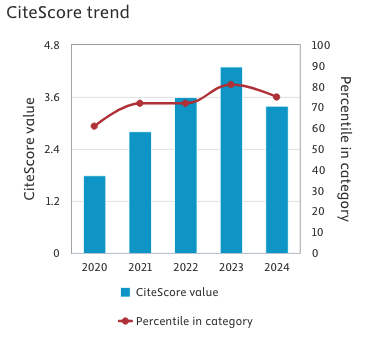Severe rhabdomyolysis induced by co-administration of cocaine and heroin in a 45 years old man treated with rosuvastatin: a case report
Rhabdomyolysis induced by cocaine and heroin in a rosuvastatin user
Keywords:
rhabdomyolysis; cocaine; heroin; statin; acute kidney injury; creatine kinaseAbstract
The term rhabdomyolysis describes a damage involving striated muscle cells or fibers, often complicated by acute kidney injury. This syndrome can have different causes, but it is generally divided into two main categories: traumatic and non-traumatic rhabdomyolysis. Among medical causes, drugs and abuse substances play a pivotal role, being opioids, alcohol, cocaine and other substances of abuse. Among drugs, the case of statins is certainly the best known. Here we describe a paradigmatic case of a man treated with success and good tolerance for years with rosuvastatin, who developed a severe rhabdomyolysis complicated by AKI needing hemodialysis, after the assumption of two substances of abuse (cocaine and heroin). Emergency physicians need to be aware of this syndrome, since it must be clinically suspected in order to ask the Laboratory for appropriate tests. Given that troponins are now widely accepted as the unique biochemical “gold standard” for diagnosing acute coronary syndromes, CK and myoglobin (the “gold standard” tests for diagnosing rhabdomyolysis) have been erased from admission test panels of the vast majority of emergency departments.
References
Petejova N, Martinek A. Acute kidney injury due to rhabdomyolysis and renal replacement therapy: a critical review. Crit Care 2014;18:224
Sauret JM, Marinides G, Wang GK. Rhabdomyolysis. Am Fam Phys 2002;65:907–912
Bosch X, Poch E, Grau J. Rhabdomyolysis and acute kidney injury. N Engl J Med 2009;361:62–72
Cervellin G, Comelli I, Lippi G. Rhabdomyolysis: historical background, clinical, diagnostic and therapeutic features. Clin Chem Lab Med 2010;48:749–756
Gonzales D. Crush syndrome. Crit Care Med 2005;333:S34–41
Huerta-Alardin AL, Varon J, Marik PE. Bench-to-bedside review: Rhabdomyolysis – an overview for clinicians. Crit Care 2005;9:158–169
Sever MS, Vanholder R, Lameire N. Management of crush-related injuries after disasters. N Engl J Med 2006;354:1052–1063
Cervellin G, Comelli I, Benatti M., et al. Non-traumatic rhabdomyolysis: Background, laboratory features, and acute clinical management Clin Biochem 2017;50:656-662
Richards JR. Rhabdomyolysis and drugs of abuse. J Emerg Med 2000;19:51-56
Welch RD, Todd K, Krause GS. Incidence of cocaine-associated rhabdomyolysis. Ann Emerg Med 1991;20:154–157
Brody SL, Wrenn KD, Wilber MM. Predicting the severity of cocaine-associated rhabdomyolysis. Ann Emerg Med 1990;19:1137–1143
Allison RC, Bedsole L. The other medical causes of rhabdomyolysis. Am J Med Sci 2003;326:79–88
SEARCH Collaborative Group, Link E, Parish S, Armitage J, Bowman L, Heath S, Matsuda F, et al. SLCO1B1 variants and statin-induced myopathy – a genomewide study. N Engl J Med 2008;359:789–799
Ramsey LB, Johnson SG, Caudle KE, et al. The clinical pharmacogenetics implementation consortium guideline for SLCO1B1 and simvastatin-induced myopathy: 2014 update. Clin Pharmacol Ther. 2014;96:423-428
Iwere RB, Hewitt J. Myopathy in older people receiving statin therapy: a systematic review and meta-analysis. Br J Clin Pharmacol 2016;80:363–371
Alfirevic A, Neely D, Armitage J, et al. Phenotype standardization for statin-induced myotoxicity. Clin Pharmacol Ther. 2014;96:470-476
Pasternak RC, Smith SC Jr, Bairey-Merz CN, et al. American College of Cardiology; American Heart Association; National Heart, Lung and Blood Institute. ACC/AHA/NHLBI Clinical advisory on the use and safety of statins. Circulation 2002;106:1024–1028
Sanchis-Gomar F, Pareja-Galeano H, Lucia A. Prevention of statin-induced myopathy--do not stop physical activity. J Physiol 2015;593:2111
Lippi G, Plebani M. Serum myoglobin assay: obsolete or still clinically useful? Clin Chem Lab Med 2016;54:1541-1543
Kasaoka S, Todani M, Kaneko T, et al. Peak value of blood myoglobin predicts acute renal failure induced by rhabdomyolysis. J Crit Care 2010;25:601–604
Altintepe L, Guney I, Tonbul Z, et al. Early and intensive fluid replacement prevents acute renal failure in the crush cases associated with spontaneous collapse of an apartment in Konya. Ren Fail 2007;29:737–741
Egholm G, Pareek M. Drug-Induced Rhabdomyolysis with Elevated Cardiac Troponin T. Case Rep Med 2015, doi.org/10.1155/2015/270204
Lippi G, Plebani M, Cervellin G. Cocaine in acute myocardial infarction. Adv Clin Chem 2010;51:53-70
Downloads
Published
Issue
Section
License
This is an Open Access article distributed under the terms of the Creative Commons Attribution License (https://creativecommons.org/licenses/by-nc/4.0) which permits unrestricted use, distribution, and reproduction in any medium, provided the original work is properly cited.
Transfer of Copyright and Permission to Reproduce Parts of Published Papers.
Authors retain the copyright for their published work. No formal permission will be required to reproduce parts (tables or illustrations) of published papers, provided the source is quoted appropriately and reproduction has no commercial intent. Reproductions with commercial intent will require written permission and payment of royalties.






